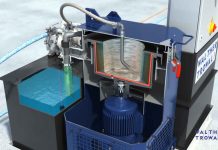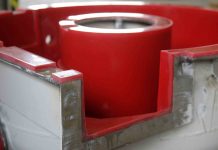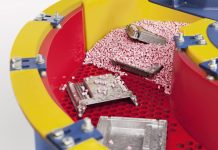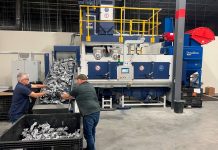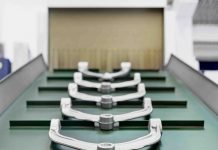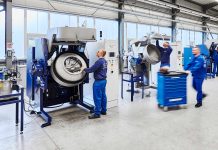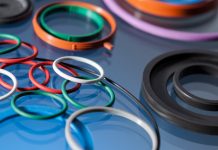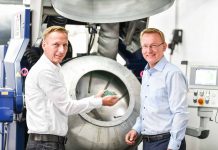20 Rotamat coaters within a radius of 10 kilometers
Find out here
- why three small villages have become the center of European small parts coating
- why most contract coaters have chosen Rotamats
- how contract coaters meet the automotive industry’s demands for maximum reproducibility
- how a start-up optimizes coating
Why contract coaters on the Lago d’Iseo choose Rotamats
Italy’s rubber industry is located in the region around Lake d’Iseo in Northern Italy. In villages such as Paratico, Sarnico and Villongo, about 200 companies manufacture components made of elastomers for the automotive and aerospace industries as well as for the fashion and furniture industries. This is why the area is called “rubber valley”
Many contract coaters have set up shop in the immediate vicinity, coating billions of small parts every year – for example, O-rings and seals for machines and vehicles, zippers for the textile industry and fittings for the furniture sector. Most of them use rotamates for this purpose.
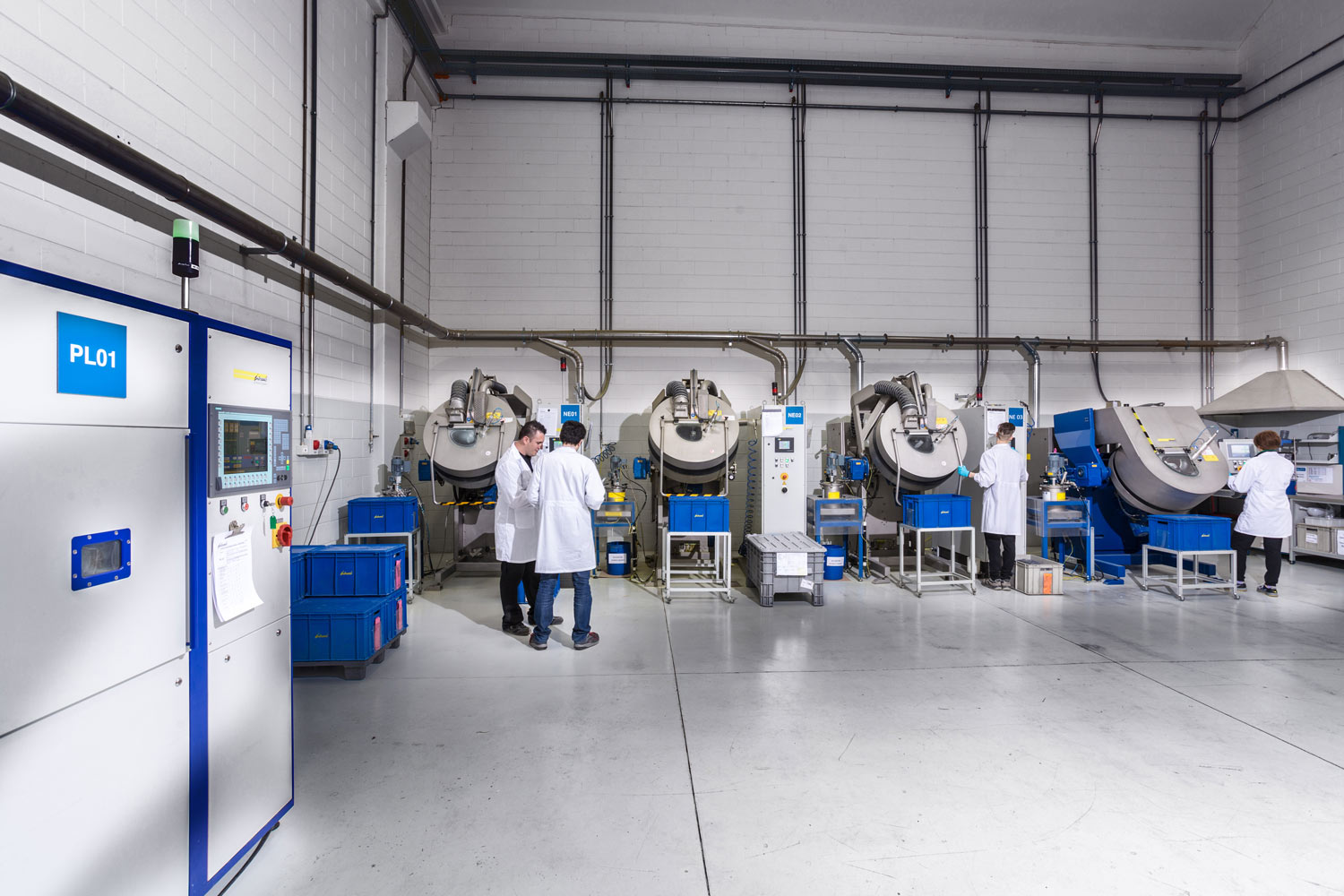
Contrary to lake Como or lake Garda, the Lago d‘Iseo is not very well known, even in Italy. Water sports fans know it as the location of the legendary motor boat yard Riva. And a few years ago the lake became temporarily famous, when Christo and Jeanne-Claude installed the yellow-golden “floating piers” at its shore.
Even less known is the fact that the lake shore is also home to Italy’s rubber industry. In villages like Paratico, Sarnico and Villongo about 200 companies are producing elastomer components for the automobile, aerospace and furniture industry. Even parts for the world of fashion are made there. Each year the companies in this area make and ship components worth several billion Euros: There is a reason why this region is called the “rubber valley” of Italy.
Many billions of small parts, such as O-rings, seals for machines and vehicles, zippers for the textile industry and furniture fittings, must be coated with anti-friction lacquers, primers or decorative paint. Therefore, it is not surprising that this region produced many coating job shops.
Especially those companies with customers in the automobile and aerospace industry, who demand high process stability and consistent results, have been using Rotamat coaters for quite some time: Within a radius of 10 kilometers 17 Rotamat coaters are currently operating. This makes the Lago d’Iseo the region with the, globally, largest concentration of Rotamat coaters from Walther Trowal. In addition, two machines are at the Lago Maggiore, and one is in Treviso, about 50 km from the Lago d’Iseo.
Interseals – seven Rotamat coaters within the same group of companies
The first coating job shop utilizing the Rotamat coating technology was Interseals in Capriolo. The company produces O-rings and specially formed components made from elastomers. In addition, the company is not only coating its own products, but within its job shop operation also coats the products of other manufacturers. Among other things Interseals has also specialized in coating technologies with multi-component lacquers. The first machine for drum coating of small components with an anti-friction lacquer was commissioned in 2009.
Today Interseals in Capriolo works with three R 90 Rotamat coaters (processing capacity of up to 50 l) and a R 90C (processing capacity of up to 75 l) with a drum diameter of 800 / 850 mm, for batch weights of about 50 / 100 kg and a processing volume of 50 / 75 l. At the subsidiary company Pol-Technology, founded in 2016 and located near Kattowitz in Poland, initially 2 Rotamat coaters were installed. 2017 a third machine was commissioned. On average, each Rotamat machine coats nearly 40 million parts per year with water based lacquers.
The world’s center for coating of mass produced small parts
Whoever wants to get a complete overview over the application possibilities of the Rotamat systems and wants to see the coaters in everyday operations, should travel to the Lago d’Iseo: Practically all users are practically a stone’s throw apart from each other.
For coating applications with anti-friction lacquer for O-rings, seals and other components alone the visitors can inspect 12 Rotamat units. Just a few steps away two machines are used for the application of decorative coatings on metal components for the fashion industry. And a little further away several Rotamat units are coating plastic components for the furniture industry with water and solvent based decorative and functional materials for products like handles and other fittings. Two additional Rotamat systems are utilized for coating connecting elements for the aerospace industry, including safety components. These products require the highest degree of process safety and consistency of coating results.
The Rotamat technology today
The first machine, commissioned at Interseals 13 years ago, is still running without any problems. However, in the meantime a lot of innovative features were integrated into the Rotamat technology. With new spraying systems, precise dosing of the material flow, intuitive operating panels and the integration of the machine controls into the higher level computer systems of the users, Walther Trowal has adapted the machines to the latest customer requirements.
New spray guns are evenly distributing the coating material on the surface of the elastomer components. At the same time, the precise control of the material flow ensures that the thickness of the material layer is exactly within the specified values. Therefore, the Rotamat coaters are especially suited for components with complex, delicate shapes and for tasks, where process safety and consistency of results are essential. Examples are two-component coatings with lacquers containing pigments or the coating with solvent based materials that must comply with special technical requirements.

For example, the dosing of the material flow is controlled with a precision of one tenth of a gram per minute. This guarantees that the coating process is always utilizing the prescribed lacquer quantity and that the required coating thickness is precisely and consistently achieved. With this new technology the coating process is now managed by exactly measured, actual data. This helps the customers, among other things, with audits: They can reliably prove that their production process takes place with a high degree of process safety and consistency.
Walther Trowal has also continuously improved its machine range. With the R 60 the company responded to numerous market demands: Many coating job shop customers are producing smaller and more compact machine components, for example, motors and pumps, which generate the same performance as the larger products. Accordingly, the seals for these devices are becoming smaller. Today the volume of 50,000 O-rings with an inner diameter of 3 mm and a cord thickness of 1 mm amounts to only 0.5 l.
However, since the coating process requires a certain minimum fill quantity, Rotamat machines with smaller drums became an urgent necessity. For this reason, Walther Trowal developed the Rotamat model R 60 with a fill volume of only 15 l but with the same technical and performance features of its “larger siblings”. The R 60 is ideal for coating small product batches. But it can also be used for the sample coating of larger components.
Moreover, Walther Trowal has opened access to the digital world of the customers: A communication processor allows the integration of the Rotamat systems into the controls of the entire manufacturing process.
With a startup into the future
The C.S.I. Centro Servizio Industriali, founded in 2021 and also located at the lake in Paratico, pursues an entirely new approach. The company is not only a manufacturer but also does R&D and provides consulting services. The focus is on three technologies
- the cryogenic deburring of, especially, small components
- the drum coating with anti-friction lacquers
- the coating with plasma and parylene systems
The company is utilizing two Rotamat coaters and will shortly commission a third unit. CSI uses its experience as coating job shop to advise companies in the region hands-on directly at the machines.

Stefano Ferrari, the founder and general manager C.S.I. explains: “Numerous job shops were founded in the 1980’s. But many experienced specialists are now retiring. This leads to a sizable loss of know-how. For this reason, we offer training courses. Many users are surprised to learn about the technical versatility of the Rotamat coaters. In addition, we are intensively working on new technologies.”
C.S.I. operates a test lab with sophisticated equipment that allows comprehensive studies for the company’s customers. This allows the companies in the lake region to demonstrate to their customers what excellent coating qualities they can produce. An important part of the work at C.S.I. is to support companies working for customers from the automobile, aerospace and medical engineering industries in the preparation of complete documentations covering process safety and consistency of the coating results.
In addition to its own production and the analytical services in its internal lab C.S.I. is also studying new materials. One important research project deals with solid lubricants with anti-microbial or bacteria resistant characteristics.
The Rotamat technology in more detail
The Rotamat systems for coating mass produced small parts are utilizing the hot drum technology, whereby the parts are coated in a closed rotating drum with one or more automatic spray guns. It allows the coating of all kinds of components made from plastic, such as elastomers, ABS, PC, PS, etc., as well as components made from metal or wood. Coating materials can be water and solvent based lacquers.
The parts must no longer be placed on special racks but are loaded into the drum of the Rotamat system as relatively large work piece batches. One or two automatic spray guns apply the coating material evenly on the surface of the parts, which are continuously tumbling over each other.
During the entire coating process pre-heated, turbulence-free air is guided into the rotating drum to heat the parts to the specified temperature. The work piece temperature is directly and continuously measured with an IR sensor. A PID controller sets the temperature depending on the work piece temperature. At the same time it takes into account the actual air flow. Because of its high efficiency, the machines require a relatively low power input of a few kW’s.
Upon completion of the coating process the work pieces are unloaded by mechanically tilting the drum downwards. Post drying, for example, in a special oven, is no longer necessary. The parts are discharged from the drum completely dry and can be immediately processed in the next manufacturing stage.



